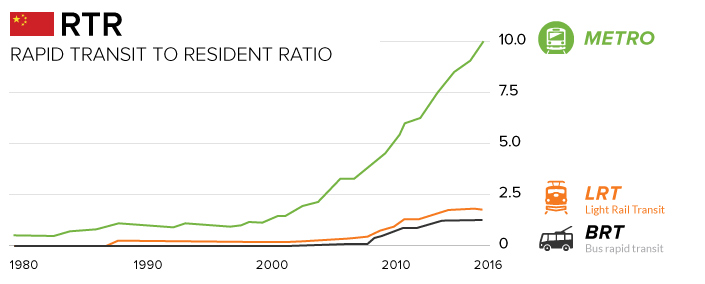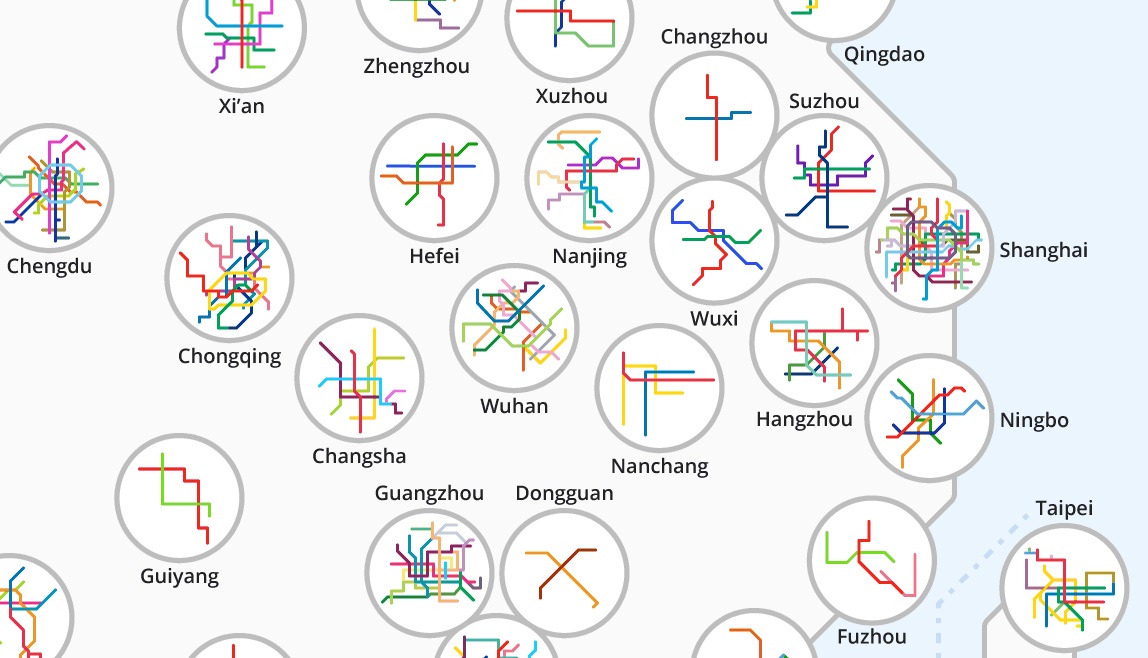The following animation from Peter Dovak shows this rapid transit revolution playing out by year:
MIND THE GAP
In the above animation, there’s a distinct uptick in the number of projects started after 2004. It was in this year that the government lifted a ban on new metro construction, after worsening congestion and pollution caused the government to rethink their stance. There has been a rapid transit boom in the country ever since. Soon, minimum population requirements for cities looking to build subway systems will be halved from 3 million to 1.5 million, and this move is expected to set off an even bigger wave of infrastructure investment in cities throughout the country.
RISING RATIOS
Hundreds of kilometers of track are being added each year. As a result of this unparalleled pace of metro construction, China’s ratio of Rapid Transit to Residents (RTR) has risen steeply over the last 15 years.
RTR is a ratio that compares the length of rapid transit lines (measured in kilometers) with the country’s urban population (measured in millions of people). As you can see, China is making great strides in building urban transit networks, though it is still catching up to countries like Germany, which has a RTR of 81. Chinese cities have a blend of attributes that make constructing metro lines an appealing option: fewer regulatory hurdles, a low cost of labor, and a high-density urban fabric. Also, because transit is treated as an essential public service (i.e. not expected to be profitable), China’s metros provide affordable mobility to its citizens. Even with Beijing’s recent metro fare increase, most rides only cost about ¥3 to ¥8, or $0.45 to $1.45. Shanghai is now home to the longest metro system by route length, and the Beijing Subway has the highest ridership in the world. Not bad for cities that lacked any substantive transit system until the 1990s.
By 2020, China is expected to have 220+ cities with over a million inhabitants, so as long as the government can continue to provide the resources and funding to expanding transit networks, the building boom will likely continue unabated. on Even while political regimes across these countries have changed over time, they’ve largely followed a few different types of governance. Today, every country can ultimately be classified into just nine broad forms of government systems. This map by Truman Du uses information from Wikipedia to map the government systems that rule the world today.
Countries By Type of Government
It’s important to note that this map charts government systems according to each country’s legal framework. Many countries have constitutions stating their de jure or legally recognized system of government, but their de facto or realized form of governance may be quite different. Here is a list of the stated government system of UN member states and observers as of January 2023: Let’s take a closer look at some of these systems.
Monarchies
Brought back into the spotlight after the death of Queen Elizabeth II of England in September 2022, this form of government has a single ruler. They carry titles from king and queen to sultan or emperor, and their government systems can be further divided into three modern types: constitutional, semi-constitutional, and absolute. A constitutional monarchy sees the monarch act as head of state within the parameters of a constitution, giving them little to no real power. For example, King Charles III is the head of 15 Commonwealth nations including Canada and Australia. However, each has their own head of government. On the other hand, a semi-constitutional monarchy lets the monarch or ruling royal family retain substantial political powers, as is the case in Jordan and Morocco. However, their monarchs still rule the country according to a democratic constitution and in concert with other institutions. Finally, an absolute monarchy is most like the monarchies of old, where the ruler has full power over governance, with modern examples including Saudi Arabia and Vatican City.
Republics
Unlike monarchies, the people hold the power in a republic government system, directly electing representatives to form government. Again, there are multiple types of modern republic governments: presidential, semi-presidential, and parliamentary. The presidential republic could be considered a direct progression from monarchies. This system has a strong and independent chief executive with extensive powers when it comes to domestic affairs and foreign policy. An example of this is the United States, where the President is both the head of state and the head of government. In a semi-presidential republic, the president is the head of state and has some executive powers that are independent of the legislature. However, the prime minister (or chancellor or equivalent title) is the head of government, responsible to the legislature along with the cabinet. Russia is a classic example of this type of government. The last type of republic system is parliamentary. In this system, the president is a figurehead, while the head of government holds real power and is validated by and accountable to the parliament. This type of system can be seen in Germany, Italy, and India and is akin to constitutional monarchies. It’s also important to point out that some parliamentary republic systems operate slightly differently. For example in South Africa, the president is both the head of state and government, but is elected directly by the legislature. This leaves them (and their ministries) potentially subject to parliamentary confidence.
One-Party State
Many of the systems above involve multiple political parties vying to rule and govern their respective countries. In a one-party state, also called a single-party state or single-party system, only one political party has the right to form government. All other political parties are either outlawed or only allowed limited participation in elections. In this system, a country’s head of state and head of government can be executive or ceremonial but political power is constitutionally linked to a single political movement. China is the most well-known example of this government system, with the General Secretary of the Communist Party of China ruling as the de facto leader since 1989.
Provisional
The final form of government is a provisional government formed as an interim or transitional government. In this system, an emergency governmental body is created to manage political transitions after the collapse of a government, or when a new state is formed. Often these evolve into fully constitutionalized systems, but sometimes they hold power for longer than expected. Some examples of countries that are considered provisional include Libya, Burkina Faso, and Chad.

















